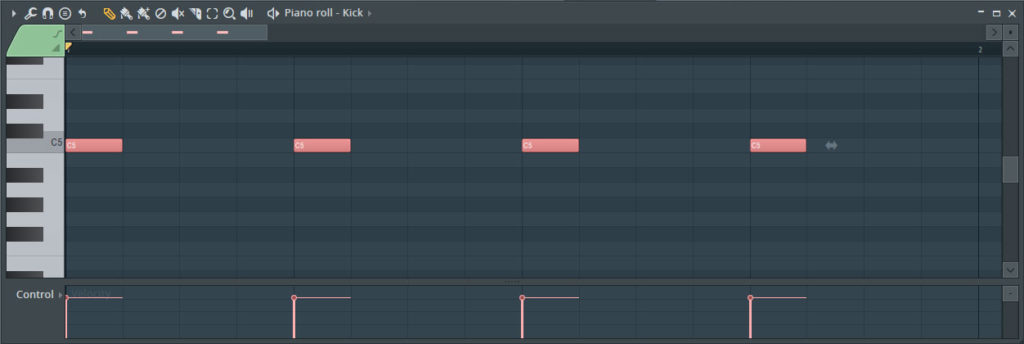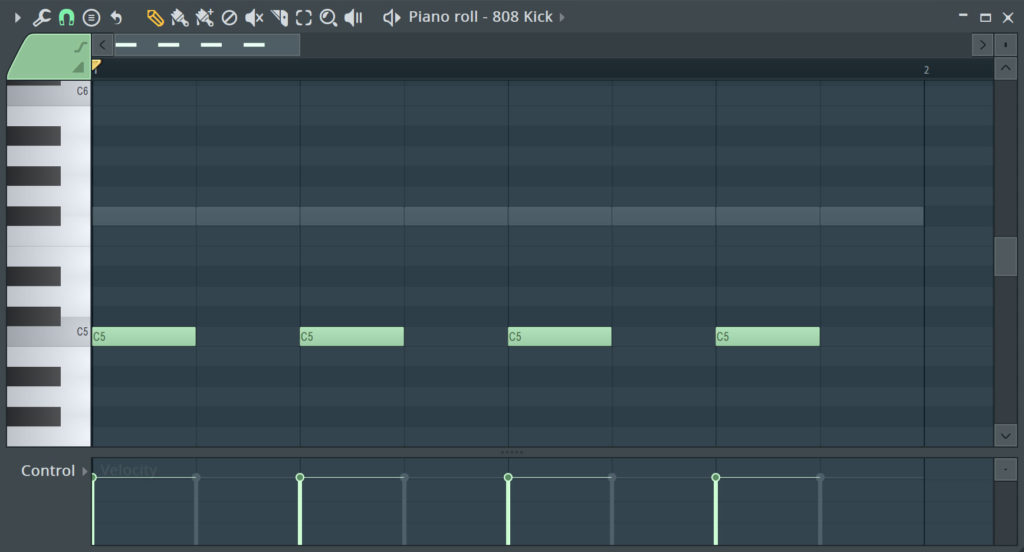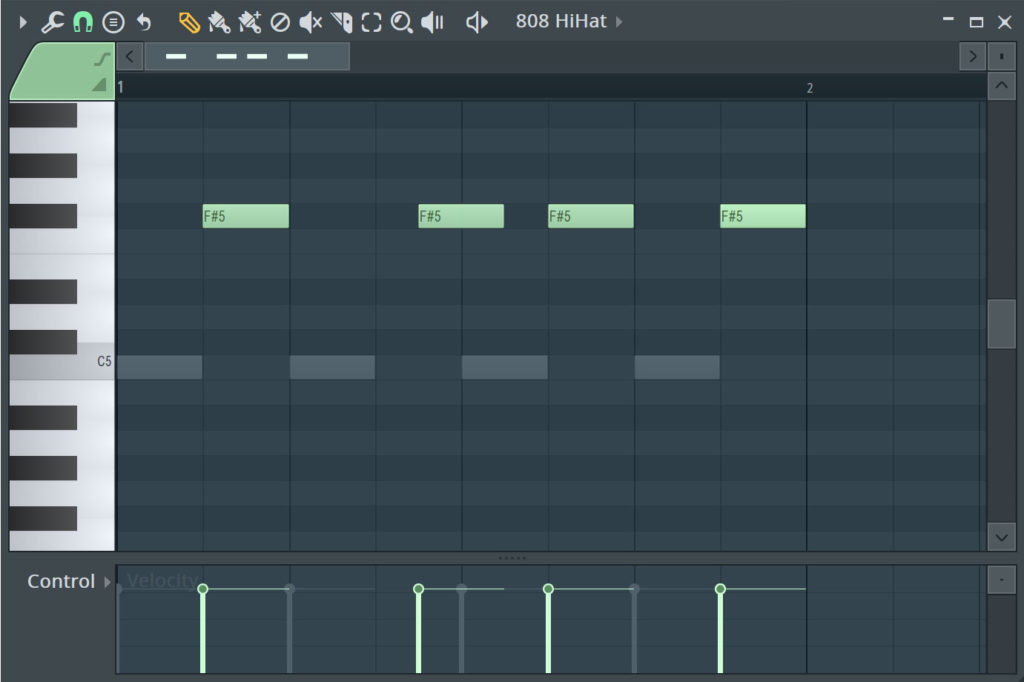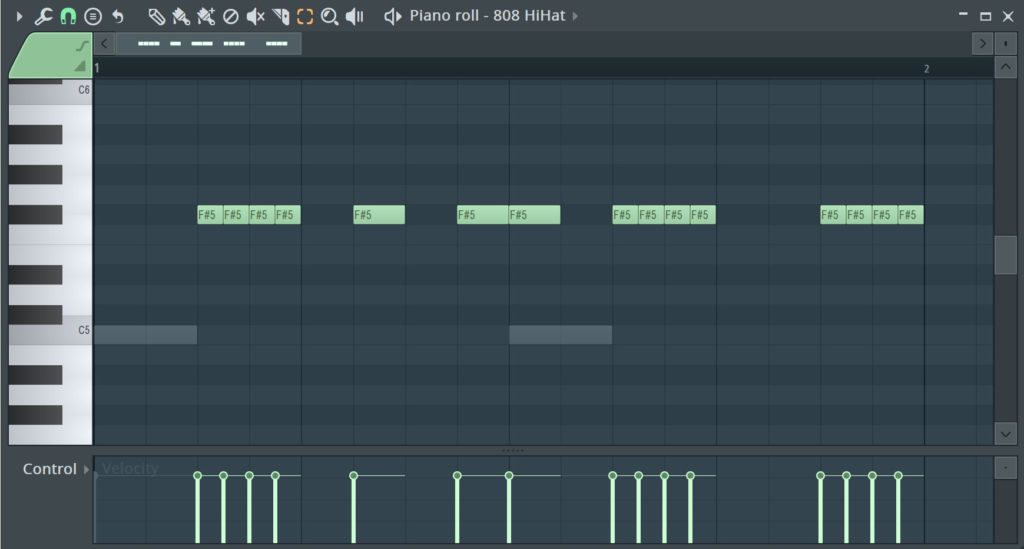+ This lesson is presented courtesy of Jlin’s course on Soundfly, Rhythm, Variation, & Vulnerability. Sign up and learn to create deeply complex rhythmic tapestries of sound, brimming with emotion.
Jlin’s music is grounded by rhythm and rhythmic complexity, so let’s spend some time honing in on that aspect of her sound, and making sure we understand the terms and concepts she uses to create her beats.
Defining Terms
First things first, let’s make sure we’re all on the same page regarding terminology. You probably know many of these already. The beat is the steady pulse that underwrites most music, often also described as the main unit of measurement for the rhythm of a piece.
We usually count the beat as: one, two, three, four, one, two, three, four, etc. These moments, especially the one, are usually felt as accents within a piece of music.
The standard four-on-the-floor beat that Jlin talks about is one where the kick part follows the beat to the letter.

Subdivisions
That beat can then be broken into subdivisions or smaller units, such as eighth notes, sixteenth notes, 32nd notes, and so on. One of the great things about modern DAWs is that they provide a grid to help visualize both the beat and these subdivisions.
In the image below, which shows a grid with a 4/4 time signature, the quarter note (1/4) follows the beat, and all the other grid lines are subdivisions.
+ Read more on Flypaper: “What Is Going on in This Noname Beat?”
Syncopation
Another very important concept for understanding Jlin’s music is syncopation.
Syncopated rhythms are rhythms in which the stresses of the rhythm don’t occur on the main pulse of the beat itself. Instead, a syncopated rhythm emphasizes either parts of the pulse that we feel more weakly or subdivisions of the beat. Sometimes these weak beats are called off-beats.
Here’s an example of a single measure in 4/4 time with the various subdivisions labeled down to 32nd notes. Beats 1 and 3 of the measure are generally considered the strongest beats since they align with where we expect to hear emphasis in the music. Then, beats 2 and 4 are a little weaker, but still fairly strong.
The further we get from there in terms of subdivisions, the “weaker” the beats are presumed to be.

Here’s an example of a non-syncopated rhythm. Notice how the kick is a classic four-on-the-floor beat, emphasizing all the significant beats within the measure. The hi-hat is playing eighth notes straight through, giving you an idea of the smaller divisions within the pattern without de-emphasizing the location of the strong beats.
These sounds align with the pulse of the music, and it all feels very straightforward.

A syncopated rhythm disrupts the natural pulse by emphasizing the weaker beats and subdivisions in some way.
Here’s an example with the same four-on-the-floor kick but with a syncopated hi-hat part. The kick emphasizes the strong beats, but the hi-hats fall somewhere in between — hitting on smaller subdivisions of the beat. You need to look at the sixteenth or eighth note grid lines to see where they fall.
Due to the syncopation, the whole thing moves a bit more than the straightforward version.

Syncopation is a critical part of understanding both Jlin’s music and a lot of modern music in general. Syncopation gives a piece a sense of movement and groove.
Here’s one last example of syncopation in action. In the example below, the kick is holding down the quarter notes, providing the pulse that gives the song its beat. It’s clearly emphasizing the strong beats and not syncopated in any way. Gradually, a tom part enters that is emphasizing the off-beats in increasingly small subdivisions. It’s highly syncopated, never falling on a strong beat.
Over time, you get a sense of how the syncopation pushes the beat rhythm forward by disrupting and dancing around the pulse.
Using Subdivisions to Create Syncopation and Variation
The great part about working with subdivisions in the grid is that there’s tons of room for trial and error to construct your parts. In essence, every spot on the grid becomes a binary — note or no note — that you can play with turning on or off to see what it sounds like.
As you zoom in on the grid in smaller and smaller subdivisions (32nd notes, 64th notes, etc.), you can access more and more precision in terms of placement, as well as stutters, fills, and glitches.
Here, we’ve used smaller 32nd-note subdivisions to create a glitchy-sounding hi-hat variation in the fourth and eighth bar of this beat:

Then, from there, you can build cool syncopated parts by placing your notes on areas of the grid that would normally be considered weak beats, or by using velocity to accent and provide additional stress to notes that fall on weak beats.
Later in Jlin’s course, we take a closer look at some detailed parts from her songs to see how she uses variation across the grid to an impactful effect.

Take a moment to experiment with syncopation and subdivisions in the DAW. Create a simple part that emphasizes the strong beats and isn’t syncopated. Then, create another part that uses subdivisions and syncopation to generate a sense of disruption and movement against the non-syncopated beat.
As you’re doing this, explore how different subdivisions of the grid give you different rhythms and feelings. Which ones stutter? Which ones drive you forward? Which ones feel very jagged and which ones flow more?
If you’re feeling good with what you’ve got, then create a variation of your original non-syncopated part to match your new syncopated part!
Don’t stop here!
Continue learning with hundreds of lessons on songwriting, mixing, DIY home recording and production, composing, beat making, and so much more in Soundfly’s courses with artists like RJD2, Ryan Lott, Kiefer, and Jlin: Rhythm, Variation, & Vulnerability.





